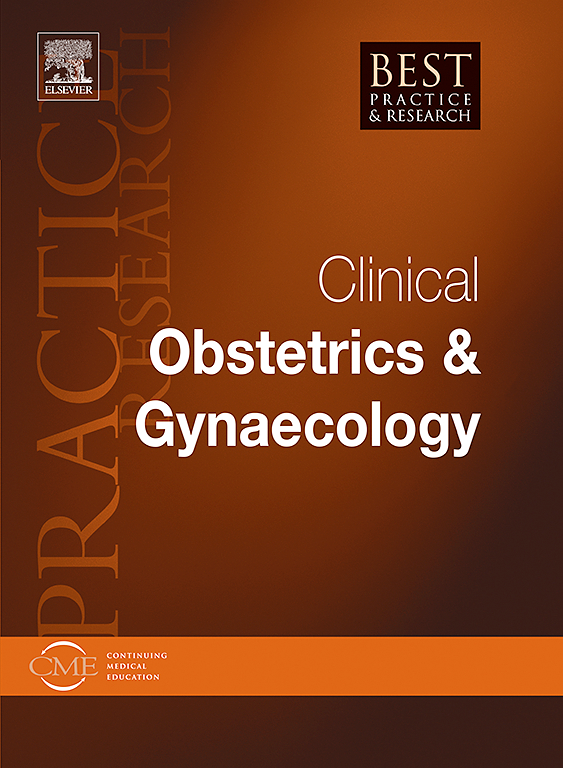Establishing ovarian toxicity assessment in oncology trials
IF 4.1
2区 医学
Q1 OBSTETRICS & GYNECOLOGY
Best Practice & Research Clinical Obstetrics & Gynaecology
Pub Date : 2025-07-22
DOI:10.1016/j.bpobgyn.2025.102642
引用次数: 0
Abstract
Premature ovarian insufficiency (POI) leading to infertility and early menopause is a serious potential adverse effect of cancer treatments. There are little robust data regarding the impact of novel classes of cancer treatment on ovarian function and fertility. Although cancer clinical trials collect very detailed information on a range of treatment-related adverse effects, ovarian toxicity is rarely assessed. In 2023, the first international research statement was published regarding assessment of ovarian toxicity in cancer clinical trials, to advocate for routine assessment of ovarian toxicity in cancer trials and to provide information to clinical trial stakeholders on how to do so, so that patients and clinicians have information about the possible long-term effects of treatment on ovarian function to facilitate informed decision-making regarding treatment options. The main recommendations from this statement are: 1) include measurement of ovarian toxicity in relevant clinical trials of anticancer agents in which premenopausal, post-pubertal patients with ovaries are enrolled, 2) collect ovarian function measures at baseline and at 12–24 months after cessation of the anticancer agent, as a minimum, and at later timepoints in line with the trial schedule, 3) include both clinical measures and biomarkers of ovarian function in clinical assessments. This statement is a key first step in prompting clinical trialists to collect ovarian function data routinely and systematically in clinical trials of anticancer agents and will, over time, enhance our understanding of novel anticancer agents and their effects on ovarian toxicity. Future work involves identifying the mechanism of ovarian toxicity for each class of novel cancer therapy, the contribution of other risk factors, such as age, and development of ovarian toxicity protection strategies.
在肿瘤试验中建立卵巢毒性评估
卵巢功能不全(POI)导致不孕和早期绝经是癌症治疗的严重潜在不良影响。关于新型癌症治疗对卵巢功能和生育能力的影响,几乎没有可靠的数据。尽管癌症临床试验收集了一系列与治疗相关的不良反应的非常详细的信息,但很少评估卵巢毒性。2023年,发表了第一份关于癌症临床试验中卵巢毒性评估的国际研究声明,倡导在癌症试验中对卵巢毒性进行常规评估,并向临床试验利益相关者提供如何进行评估的信息,以便患者和临床医生了解治疗对卵巢功能可能产生的长期影响,从而促进对治疗方案的知情决策。该声明的主要建议是:1)在相关的抗癌药物临床试验中,包括绝经前、青春期后卵巢患者的卵巢毒性测量,2)在基线和停止抗癌药物后12-24个月收集卵巢功能测量,至少在试验计划的后期收集,3)在临床评估中包括临床测量和卵巢功能的生物标志物。这一声明是促使临床试验人员在抗癌药物的临床试验中常规和系统地收集卵巢功能数据的关键的第一步,并且随着时间的推移,将增强我们对新型抗癌药物及其对卵巢毒性作用的理解。未来的工作包括确定每一类新型癌症治疗的卵巢毒性机制,其他风险因素的贡献,如年龄,以及卵巢毒性保护策略的发展。
本文章由计算机程序翻译,如有差异,请以英文原文为准。
求助全文
约1分钟内获得全文
求助全文
来源期刊
CiteScore
9.40
自引率
1.80%
发文量
113
审稿时长
54 days
期刊介绍:
In practical paperback format, each 200 page topic-based issue of Best Practice & Research Clinical Obstetrics & Gynaecology will provide a comprehensive review of current clinical practice and thinking within the specialties of obstetrics and gynaecology.
All chapters take the form of practical, evidence-based reviews that seek to address key clinical issues of diagnosis, treatment and patient management.
Each issue follows a problem-orientated approach that focuses on the key questions to be addressed, clearly defining what is known and not known. Management will be described in practical terms so that it can be applied to the individual patient.

 求助内容:
求助内容: 应助结果提醒方式:
应助结果提醒方式:


